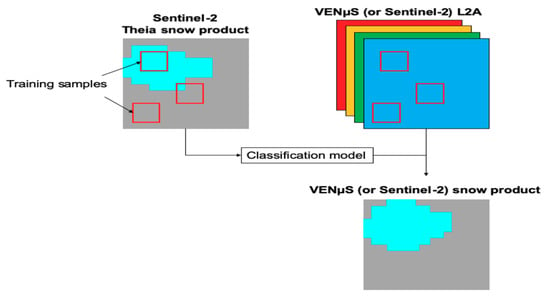Evaluation of Methods for Mapping the Snow Cover Area at High Spatio-Temporal Resolution with VENμS
Abstract
1. Introduction
2. Data and Methods
2.1. Data
2.1.1. Sentinel-2 Level-2A Products
2.1.2. Sentinel-2 Snow Products
2.1.3. VENS Level-2A Products
2.2. Methods
2.2.1. Unsupervised Classification
2.2.2. Supervised Classification
2.3. Evaluation Strategy
2.4. Evaluation Criteria
3. Results
3.1. Evaluation Using Sentinel-2 as Input Data
3.2. Evaluation Using VENS as Input Data
4. Discussion and Conclusions
Supplementary Materials
Author Contributions
Funding
Acknowledgments
Conflicts of Interest
References
- Fierz, C.; Armstrong, R.L.; Durand, Y.; Etchevers, P.; Greene, E.; McClung, D.M.; Nishimura, K.; Satyawali, P.K.; Sokratov, S.A. The International Classificationi for Seasonal Snow on the Groun; UNESCO/IHP: Paris, France, 2009; Volume 5. [Google Scholar]
- Evans, B.M.; Walker, D.A.; Benson, C.S.; Nordstrand, E.A.; Petersen, G.W. Spatial interrelationships between terrain, snow distribution and vegetation patterns at an arctic foothills site in Alaska. Ecography 1989, 12, 270–278. [Google Scholar] [CrossRef]
- López-Moreno, J.I.; Revuelto, J.; Fassnacht, S.R.; Azorín-Molina, C.; Vicente-Serrano, S.M.; Morán-Tejeda, E.; Sexstone, G.A. Snowpack variability across various spatio-temporal resolutions. Hydrol. Process. 2015, 29, 1213–1224. [Google Scholar] [CrossRef]
- DeBeer, C.M.; Pomeroy, J.W. Modelling snow melt and snowcover depletion in a small alpine cirque, Canadian Rocky Mountains. Hydrol. Process. 2009, 23, 2584–2599. [Google Scholar] [CrossRef]
- Carlson, B.Z.; Choler, P.; Renaud, J.; Dedieu, J.P.; Thuiller, W. Modelling snow cover duration improves predictions of functional and taxonomic diversity for alpine plant communities. Ann. Bot. 2015, 116, 1023–1034. [Google Scholar] [CrossRef]
- Margulis, S.A.; Girotto, M.; Cortés, G.; Durand, M. A particle batch smoother approach to snow water equivalent estimation. J. Hydrometeorol. 2015, 16, 1752–1772. [Google Scholar] [CrossRef]
- Baba, M.; Gascoin, S.; Jarlan, L.; Simonneaux, V.; Hanich, L. Variations of the Snow Water Equivalent in the Ourika Catchment (Morocco) over 2000–2018 Using Downscaled MERRA-2 Data. Water 2018, 10, 1120. [Google Scholar] [CrossRef]
- Topaz, J.; Tinto, F.; Hagolle, O. The VENμS super-spectral camera. Sensors, Systems, and Next-Generation Satellites X. Int. Soc. Opt. Photonics 2006, 6361, 63611E. [Google Scholar]
- Ferrier, P.; Crebassol, P.; Dedieu, G.; Hagolle, O.; Meygret, A.; Tinto, F.; Yaniv, Y.; Herscovitz, J. VENμS (Vegetation and environment monitoring on a new micro satellite). In Proceedings of the 2010 IEEE International Geoscience and Remote Sensing Symposium, Honolulu, HI, USA, 25–30 July 2010; pp. 3736–3739. [Google Scholar]
- French, A.N.; Hunsaker, D.J.; Sanchez, C.A.; Saber, M.; Gonzalez, J.R.; Anderson, R. Satellite-based NDVI crop coefficients and evapotranspiration with eddy covariance validation for multiple durum wheat fields in the US Southwest. Agric. Water Manag. 2020, 239, 106266. [Google Scholar] [CrossRef]
- Hagolle, O.; Huc, M.; Pascual, D.V.; Dedieu, G. A multi-temporal method for cloud detection, applied to FORMOSAT-2, VENμS, LANDSAT and SENTINEL-2 images. Remote Sens. Environ. 2010, 114, 1747–1755. [Google Scholar] [CrossRef]
- Lonjou, V.; Desjardins, C.; Hagolle, O.; Petrucci, B.; Tremas, T.; Dejus, M.; Makarau, A.; Auer, S. Maccs-atcor joint algorithm (maja). Remote Sensing of Clouds and the Atmosphere XXI. Int. Soc. Opt. Photonics 2016, 10001, 1000107. [Google Scholar]
- Gascoin, S.; Grizonnet, M.; Bouchet, M.; Salgues, G.; Hagolle, O. Theia Snow collection: High-resolution operational snow cover maps from Sentinel-2 and Landsat-8 data. Earth Syst. Sci. Data 2019, 11, 493–514. [Google Scholar] [CrossRef]
- Dozier, J. Spectral signature of alpine snow cover from the Landsat Thematic Mapper. Remote Sens. Environ. 1989, 28, 9–22. [Google Scholar] [CrossRef]
- Hall, D.K.; Riggs, G.A.; Salomonson, V.V.; Barton, J.; Casey, K.; Chien, J.; DiGirolamo, N.; Klein, A.; Powell, H.; Tait, A. Algorithm theoretical basis document (ATBD) for the MODIS snow and sea ice-mapping algorithms. NASA Gsfc 2001, 45, 15–16. [Google Scholar]
- Sirguey, P.; Mathieu, R.; Arnaud, Y. Subpixel monitoring of the seasonal snow cover with MODIS at 250 m spatial resolution in the Southern Alps of New Zealand: Methodology and accuracy assessment. Remote Sens. Environ. 2009, 113, 160–181. [Google Scholar] [CrossRef]
- Warren, S.G. Optical properties of snow. Rev. Geophys. 1982, 20, 67–89. [Google Scholar] [CrossRef]
- Dumont, M.; Gascoin, S. Optical remote sensing of snow cover. In Land Surface Remote Sensing in Continental Hydrology; Elsevier: Amsterdam, The Netherlands, 2017; pp. 115–137. [Google Scholar]
- Bühler, Y.; Meier, L.; Meister, R. Continuous, high resolution snow surface type mapping in high alpine terrain using WorldView-2 data. Digit. Globe. 2011, p. 2. Available online: https://www.researchgate.net/profile/Roland_Meister2/publication/267859153_Continuous_high_resolution_snow_surface_type_mapping_in_high_alpine_terrain_using_WorldView-2_data/links/547370c10cf2d67fc0373851.pdf (accessed on 15 June 2020).
- Marchane, A.; Jarlan, L.; Hanich, L.; Boudhar, A.; Gascoin, S.; Tavernier, A.; Filali, N.; Le Page, M.; Hagolle, O.; Berjamy, B. Assessment of daily MODIS snow cover products to monitor snow cover dynamics over the Moroccan Atlas mountain range. Remote Sens. Environ. 2015, 160, 72–86. [Google Scholar] [CrossRef]
- Hagolle, O.; Huc, M.; Desjardins, C.; Auer, S.; Richter, R. MAJA Algorithm Theoretical Basis Document; CNES-DLR: Berlin, German, 2017. [Google Scholar] [CrossRef]
- THEIA MUSCATE Production. Available online: https://theia.cnes.fr (accessed on 15 May 2018).
- Baba, M.W.; Gascoin, S.; Kinnard, C.; Marchane, A.; Hanich, L. Effect of Digital Elevation Model Resolution on the Simulation of the Snow Cover Evolution in the High Atlas. Water Resour. Res. 2018. [Google Scholar] [CrossRef]
- Foody, G.M.; Mathur, A. Toward intelligent training of supervised image classifications: Directing training data acquisition for SVM classification. Remote Sens. Environ. 2004, 93, 107–117. [Google Scholar] [CrossRef]
- Grizonnet, M.; Michel, J.; Poughon, V.; Inglada, J.; Savinaud, M.; Cresson, R. Orfeo ToolBox: Open source processing of remote sensing images. Open Geospat. Data Softw. Stand. 2017, 2, 15. [Google Scholar] [CrossRef]
- Gascoin, S.; Hagolle, O.; Huc, M.; Jarlan, L.; Dejoux, J.F.; Szczypta, C.; Marti, R.; Sánchez, R. A snow cover climatology for the Pyrenees from MODIS snow products. Hydrol. Earth Syst. Sci. 2015, 19, 2337–2351. [Google Scholar] [CrossRef]
- Notarnicola, C.; Duguay, M.; Moelg, N.; Schellenberger, T.; Tetzlaff, A.; Monsorno, R.; Costa, A.; Steurer, C.; Zebisch, M. Snow cover maps from MODIS images at 250 m resolution, part 2: Validation. Remote Sens. 2013, 5, 1568–1587. [Google Scholar] [CrossRef]
- Michael, Y.; Lensky, I.M.; Brenner, S.; Tchetchik, A.; Tessler, N.; Helman, D. Economic assessment of fire damage to urban forest in the wildland–urban interface using planet satellites constellation images. Remote Sens. 2018, 10, 1479. [Google Scholar] [CrossRef]


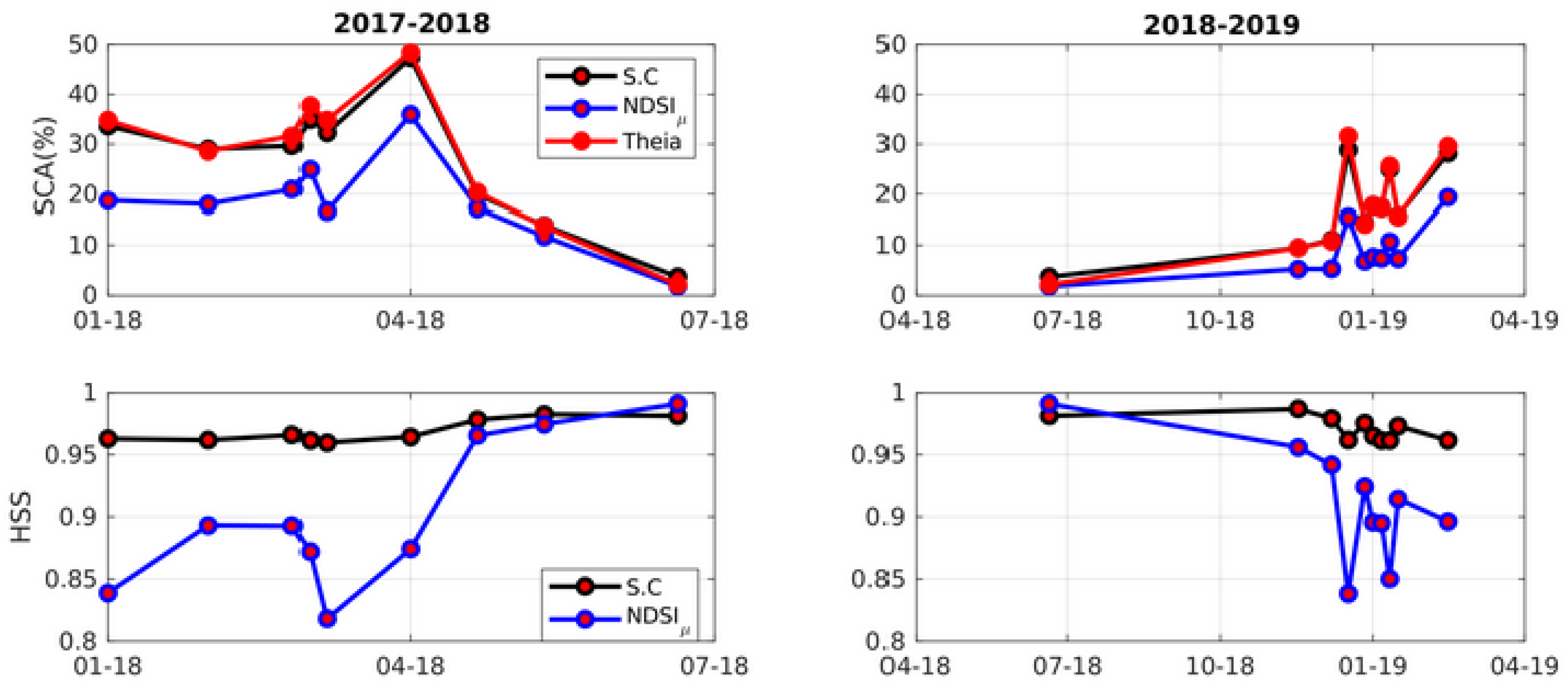
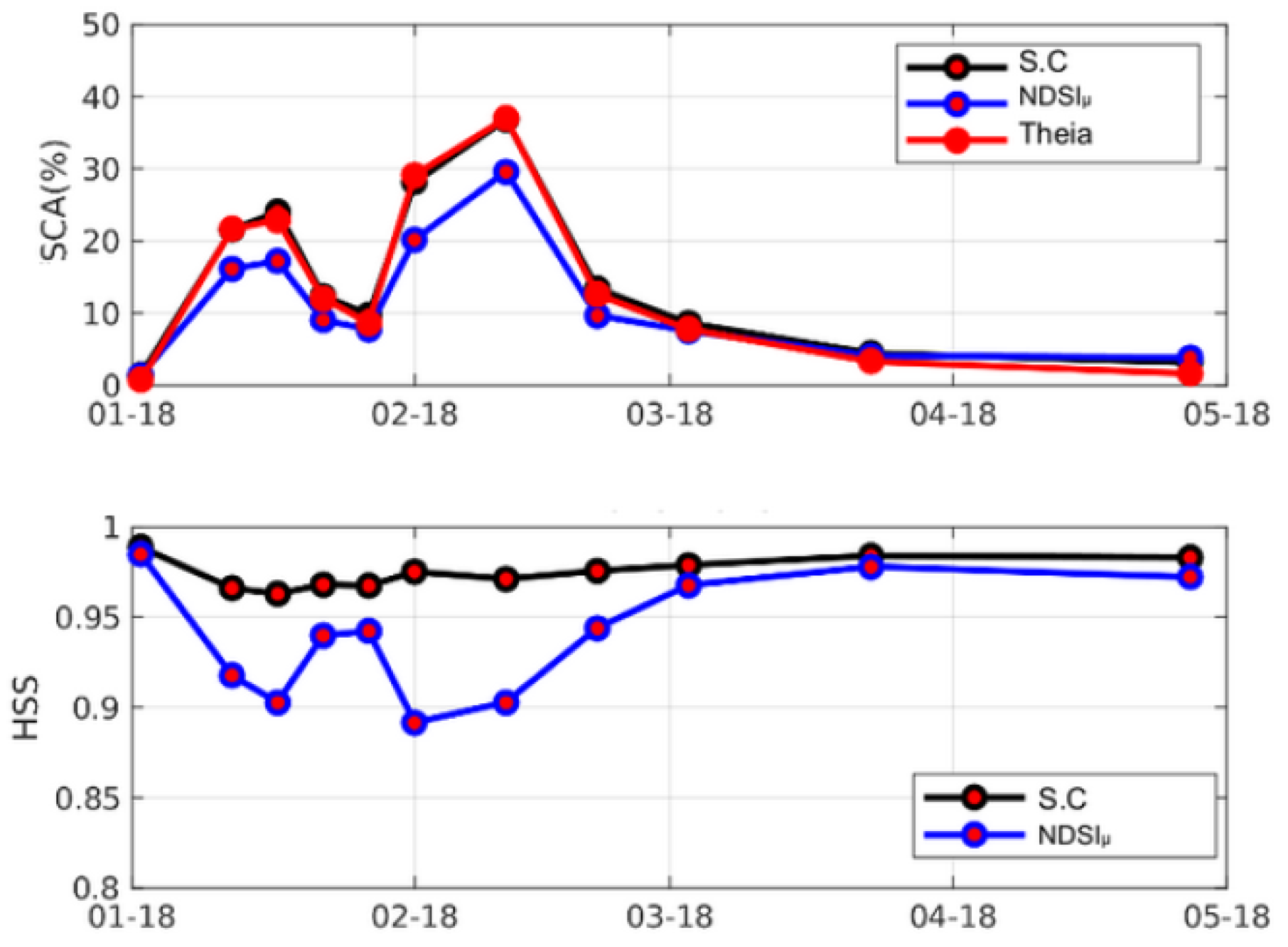
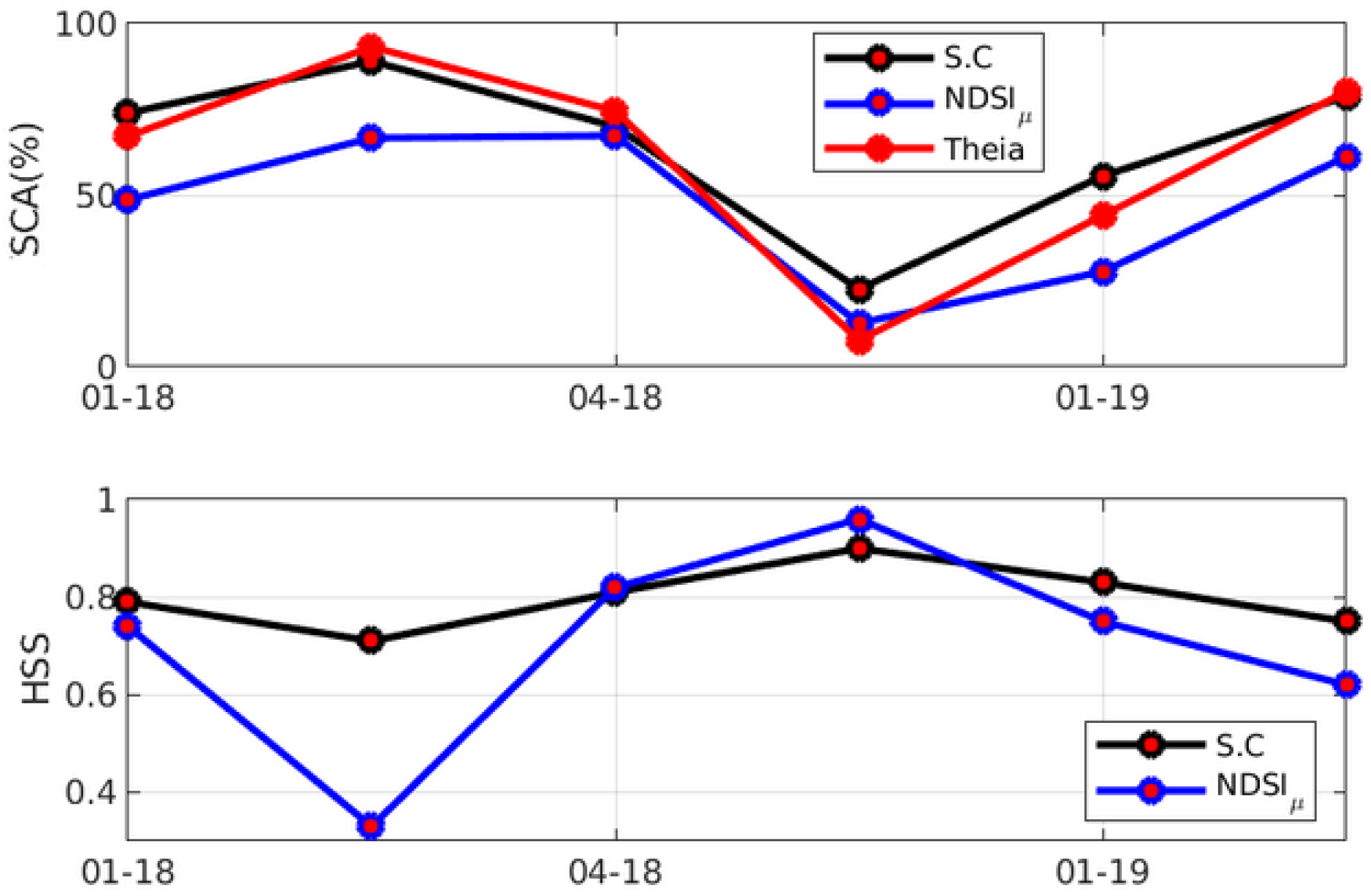
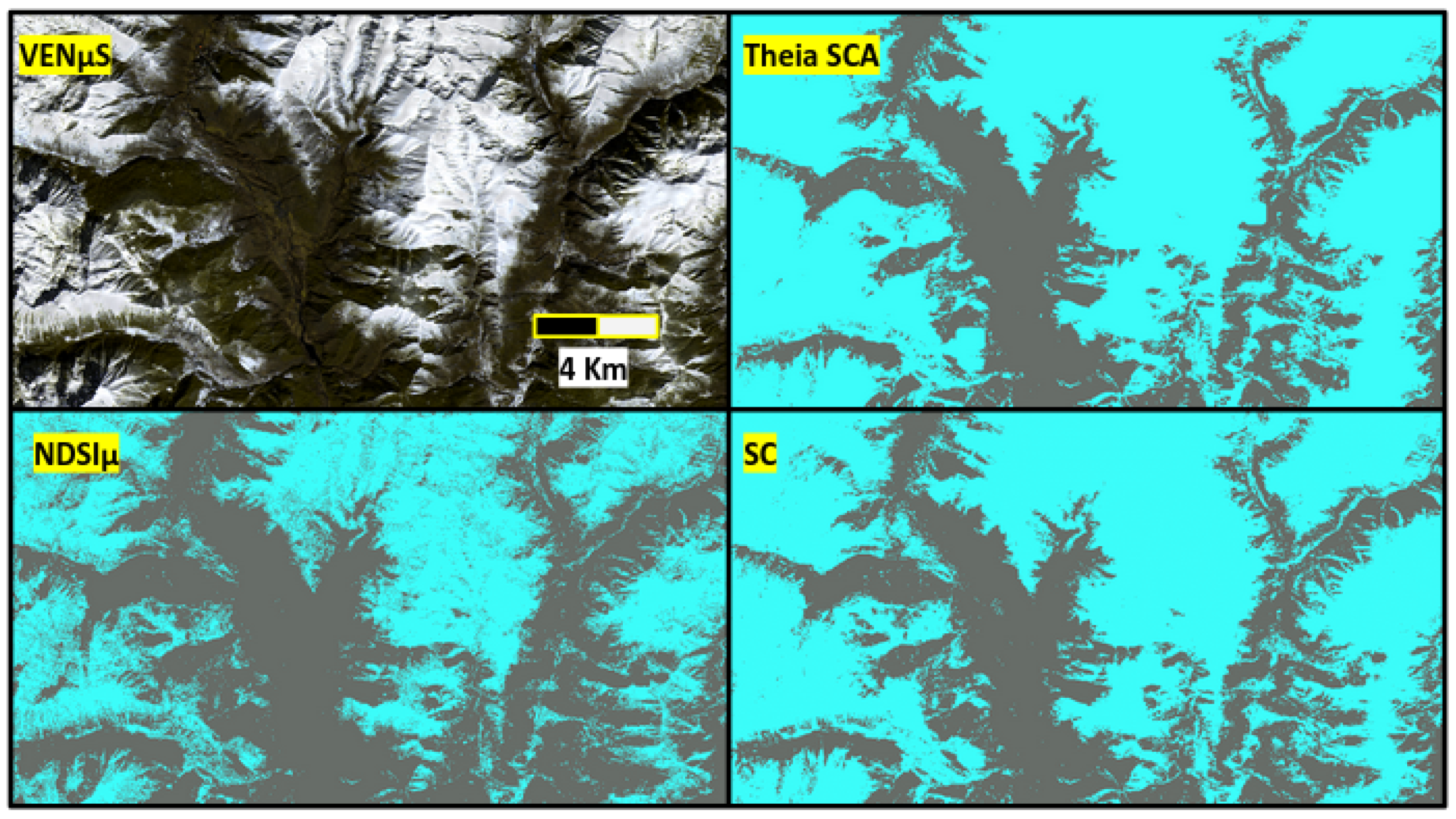
| VENS | Sentinel-2 | ||
|---|---|---|---|
| Number | Wavelength Center (nm) | Number | Wavelength Center (nm) |
| 1 | 423.9 | - | - |
| 2 | 446.9 | 1 | 443.0 |
| 3 | 491.9 | 2 | 490.0 |
| 4 | 555.0 | 3 | 560.0 |
| 5 | 619.7 | - | - |
| 6 | 619.5 | - | - |
| 7 | 662.2 | 4 | 665.0 |
| 8 | 702.0 | 5 | 705 |
| 9 | 741.1 | 6 | 740 |
| 10 | 782.2 | 7 | 783 |
| 11 | 861.1 | 8a | 865 |
| 12 | 908.7 | - | - |
| Tile High Atlas (S2) | Tile Pyrenees (S2) | Tile Pyrenees (VENS) | |||
|---|---|---|---|---|---|
| Dates | Tile | Date | Tile | Date | Tile |
| 2 January 2018 | T29RPQ | 1 January 2018 | T31TCH | 31 January 2018 | SUDOUE-5 |
| 12 January 2018 | T29RPQ | 31 January 2018 | T31TCH | 2 March 2018 | SUDOUE-5 |
| 17 January 2018 | T29RPQ | 25 February 2018 | T31TCH | 21 April 2018 | SUDOUE-5 |
| 22 January 2018 | T29RPQ | 2 March 2018 | T31TCH | 20 June 2018 | SUDOUE-5 |
| 27 January 2018 | T29RPQ | 7 March 2018 | T31TCH | 6 January 2019 | SUDOUE-5 |
| 1 February 2018 | T29RPQ | 1 April 2018 | T31TCH | 15 February 2019 | SUDOUE-5 |
| 1 February 2018 | T29RPQ | 21 April 2018 | T31TCH | — | — |
| 11 February 2018 | T29RPQ | 11 May 2018 | T31TCH | — | — |
| 21 February 2018 | T29RPQ | 20 June 2018 | T31TCH | — | — |
| 3 March 2018 | T29RPQ | 17 November 2018 | T31TCH | — | — |
| 23 March 2018 | T29RPQ | 7 December 2018 | T31TCH | — | — |
| 27 April 2018 | T29RPQ | 17 December 2018 | T31TCH | — | — |
| — | — | 27 December 2018 | T31TCH | — | — |
| — | — | 1 January 2019 | T31TCH | — | — |
| — | — | 6 January 2019 | T31TCH | — | — |
| — | — | 11 January 2019 | T31TCH | — | — |
| — | — | 16 January 2019 | T31TCH | — | — |
| — | — | 15 February 2019 | T31TCH | — | — |
© 2020 by the authors. Licensee MDPI, Basel, Switzerland. This article is an open access article distributed under the terms and conditions of the Creative Commons Attribution (CC BY) license (http://creativecommons.org/licenses/by/4.0/).
Share and Cite
Baba, M.W.; Gascoin, S.; Hagolle, O.; Bourgeois, E.; Desjardins, C.; Dedieu, G. Evaluation of Methods for Mapping the Snow Cover Area at High Spatio-Temporal Resolution with VENμS. Remote Sens. 2020, 12, 3058. https://doi.org/10.3390/rs12183058
Baba MW, Gascoin S, Hagolle O, Bourgeois E, Desjardins C, Dedieu G. Evaluation of Methods for Mapping the Snow Cover Area at High Spatio-Temporal Resolution with VENμS. Remote Sensing. 2020; 12(18):3058. https://doi.org/10.3390/rs12183058
Chicago/Turabian StyleBaba, Mohamed Wassim, Simon Gascoin, Olivier Hagolle, Elsa Bourgeois, Camille Desjardins, and Gérard Dedieu. 2020. "Evaluation of Methods for Mapping the Snow Cover Area at High Spatio-Temporal Resolution with VENμS" Remote Sensing 12, no. 18: 3058. https://doi.org/10.3390/rs12183058
APA StyleBaba, M. W., Gascoin, S., Hagolle, O., Bourgeois, E., Desjardins, C., & Dedieu, G. (2020). Evaluation of Methods for Mapping the Snow Cover Area at High Spatio-Temporal Resolution with VENμS. Remote Sensing, 12(18), 3058. https://doi.org/10.3390/rs12183058





